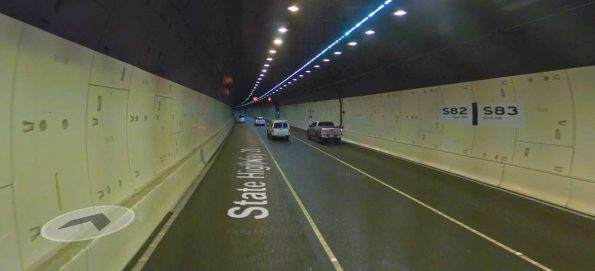How many vehicle accidents happen in and around tunnels?
Tunnels themselves are relatively safe compared with other parts of the road network, but there are still a significant number of crashes. The majority of crashes are due to lane changes (i.e. side-swipe) and nose-to-tail – these represent 93% of all crashes – and they are most common near the tunnel’s entry and exit points. If a crash involves multiple vehicles it can be severe, especially if one of the vehicles catches on fire.
What causes tunnel accidents
Driver error is the overwhelming cause of accidents in tunnels, but some characteristics of tunnels contributes to this:
- Tunnels are expensive so they are dug to the minimum width to be considered ‘safe’. Lanes are rarely ‘generous’ and this leaves less margin for error. In two-way tunnels, this means vehicles are closer together when they pass.
- As there are no run-off areas or hard shoulders in tunnels, motorists have fewer options to take evasive action. As you can see in this photo of the Waterview Tunnel in Auckland, New Zealand, there is no shoulder at all and the lanes are fairly narrow.

- Tunnels often have lanes merging before the entry, creating a risk point
- The change in light levels is difficult for drivers, especially older drivers whose eyes take longer to adjust
- Driver behaviour contributes greatly: frustration at drivers that are timid, coupled with too much aggression from other drivers causes dangerous overtaking and incidences of tailgating. Drivers often try to anticipate which lane will be moving faster just before they enter the tunnel, leading to unnecessary lane changes
- Tunnel accidents cause much greater traffic congestion and for longer because the vehicles cannot be easily moved out of the lanes
- Drivers tend to move away from the tunnel walls when driving through tunnels, leaving less margin to vehicles in the lane next to them
- The beginning and ends of the tunnel are the only points in the tunnel where the road can get wet
- Trucks in tunnels increase the crash risk.
How can tunnel accidents be reduced?
- Discouraging overtaking all but eliminates side-swipe accidents. It also keeps traffic moving more consistently by reducing the number of jamitons.
- Providing shoulders and breakdown bays keeps traffic flowing more smoothly
- Banning trucks either completely or between certain times reduces risk
- Methods to encourage safe speeds (e.g. variable speeds based on the conditions) and improving lane discipline (e.g. rumble strips) reduces risk
- Improving lighting, particularly within the first and last 100m, makes it easier for drivers to adjust their eyes. Implementing variable lighting that matches the level of light outside the tunnel also helps. This means that the tunnel will be less brightly lit at night
- Using appropriate wall colours – lighter walls are better for safety
- Orienting the tunnel entrance and exit to avoid driving directly into a setting or rising sun
- Better signage about traffic conditions ahead prepares drivers to react accordingly
- Designing tunnels so that drivers can see further ahead
- Limit signage in the first 100-400m as to not overload a driver that’s already transitioning
- Avoid gradients of more than 5 degrees – a study found that a gradient of more than 5 degrees increases accidents by around 13%
- Automated detection of tunnel incidents so that emergency services can be dispatched quickly to minimise disruption.
Drivers
- Don’t enter a tunnel if you’re running very low on fuel
- Turn on your headlights and take your sunglasses off
- Maintain a 2-second gap to the vehicle in front
- Keep a consistent speed
- Don’t change lanes
Are tunnels safer in some circumstances?
Tunnels are much safer than above ground urban roads, showing around a 61% reduction in the number of accidents. They are marginally safer than motorways and rural roads. Tunnels are safer lanes are in a single direction.
What should you do if you have an accident in a tunnel?
If your vehicle catches fire, try to drive it out of the tunnel if possible. If not, pull it as far left as possible and get out. Don’t open your bonnet. Use an emergency exit.
If you have a minor accident, it’s best to deal with it outside the tunnel, on the hard shoulder. Swap details with the other party and then drive out of the tunnel to minimise the disruption.
If you have an accident where your car is incapacitated, turn your hazard lights on, stay with the car, call emergency services and wait.
If an accident has happened ahead of you and you are stationary, stay in your car, turn your air conditioning to recirculate, switch your engine off (but keep the ignition on) and turn on the radio for updates. If you have to get out of your vehicle, watch for motorbikes filtering. Watch for information boards that will tell you whether you need to evacuate.
